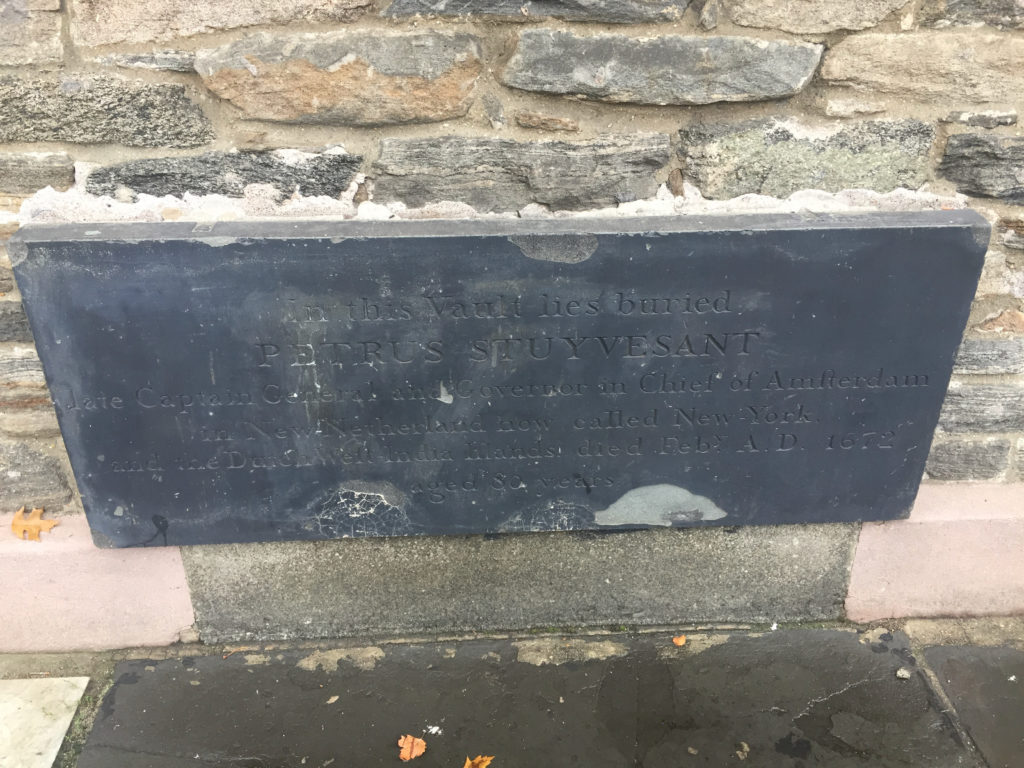Erik Visits an American Grave, Part 785
This is the grave of Peter Stuyvesant.

Born in approximately 1592 in Friesland, the Netherlands, Stuyvesant grew up the son of a Calvinist minister, which definitely rubbed off on him. He went to the University of Franeker. He studied languages and philosophy but then was evicted from the university after he seduced the daughter of his landlord. So he joined the Dutch East India Company. He rose in that colonialist nation that was making the Dutch among the world’s wealthiest people. He became a very active colonialist. In 1630, the Company sent him to Brazil, where it had interests at that time. First, he was the agent for a small island just off the coast and then to Pernambuco. He was then sent to Curacao and then became governor of that island colony, as well as Aruba and Bonaire.
An ambitious colonialist, in 1644 Stuyvesant launched an attack on Spanish forces on St. Martin, which was briefly a Dutch colony the Spanish had taken over. Although the attack was not terribly run, he wasn’t able to win or engage in an effective siege. The fort got reinforcements from Puerto Rico. Then Stuyvesant was shot in the leg, which was amputated below the knee. The invasion failed. He had to go back to the Netherlands to be fit with a peg leg. Now, if I had my leg shot off in a war, I don’t exactly know what I would say. But I doubt I would say, as Stuyvesant did, that it was a blessing from Christ telling him he was special and destined to greatness because he didn’t die.
Whatever he thought God was telling him, the Dutch decided to send Stuyvesant to New Netherland, in what would soon become New York, in 1645. He didn’t actually get there until 1647, during which time he finally got married. It was kind of a loser position. New Netherland was an economic and political backwater compared to the Caribbean. The English were moving into the region at much faster rates than the Dutch. Connecticut was a rapidly growing English colony that was just a few miles away. A 1650 treaty forced Stuyvesant to give up Dutch claims on the Connecticut Valley.
Stuyvesant was also a distinctly unpleasant human being, someone who was deeply committed to his own righteousness while believing that anyone who wasn’t a Dutch Calvinist was basically a sinner. He hated the idea of religious freedom. In 1657, he refused to allow a group of Lutherans to open a church. A committed anti-Semite, he faced the reality that a lot of the merchants in New Netherland were Jewish and Jews were leaving Europe for America for religious freedom. When a group of Jews showed up after leaving discrimination in Brazil, he didn’t want to let them in. Writing back to Amsterdam, he stated ,”the deceitful race, — such hateful enemies and blasphemers of the name of Christ, — be not allowed to further infect and trouble this new colony.” Even worse, allowing Jews might…gasp…lead to Catholics! “Jewish settlers should not be granted the same liberties enjoyed by Jews in Holland, lest members of other persecuted minority groups, such as Roman Catholics, be attracted to the colony.” So that’s the kind of guy Stuyvesant was. The Dutch government revoked all his orders on these issues, as Amsterdam was a lot more committed to tolerance than their fanatical governor of New Netherland. He didn’t learn. In 1657, the Quakers showed up. He had their leader tortured.
Stuyvesant was equally dictatorial to the Dutch colonists he governed, basically declaring war on the governing council of the colony. New Netherland was also a huge slavery center, more than anywhere else in the mid-17th century future U.S. territories. Because it was so small though, albeit with large territorial claims that included all of New Jersey, the English colonies constantly enticed slaves to leave for Connecticut or Maryland. Finally, in 1664, the English pressed the Dutch to give up their colony. Hilariously, the one thing Stuyvesant worked for in the transfer was freedom of religion for the Dutch. He returned to Amsterdam for about a year to report on his years as governor. The Dutch blamed him for screwing it all up. That’s probably slightly unfair, but he was a dictator and a lot of people weren’t that sad to see him go, even if it meant the British. With nothing really left for him in the Netherlands, Stuyvesant then came to back to what was now New York. He died in 1672.
Peter Stuyvesant is buried in St. Mark’s Church, Manhattan, New York. This church of course did not exist when he was alive. But it is on the site of his family’s personal chapel.
If you would like this series to visit other colonial era Americans, you can donate to cover the required expenses here. Thomas Hooker is in Hartford and Myles Standish is in Duxbury, Massachusetts. Previous posts in this series are archived here.


